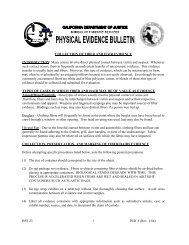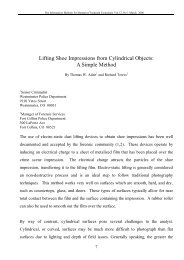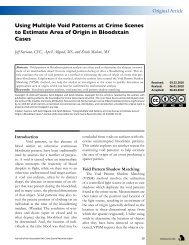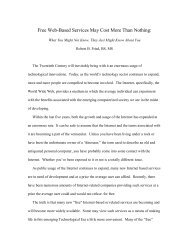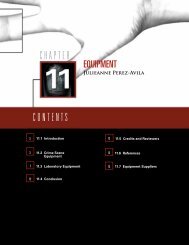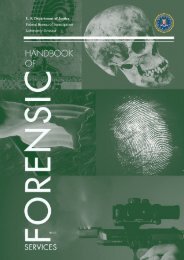PHYSICAL EVIDENCE MANUAL - Crime Scene Investigator Network
PHYSICAL EVIDENCE MANUAL - Crime Scene Investigator Network
PHYSICAL EVIDENCE MANUAL - Crime Scene Investigator Network
You also want an ePaper? Increase the reach of your titles
YUMPU automatically turns print PDFs into web optimized ePapers that Google loves.
Physical Evidence Manual<br />
10.0 FINGERPRINTS (FRICTION RIDGE SKIN)<br />
<strong>EVIDENCE</strong><br />
Fingerprints (friction ridge skin) are a widely recognized means of personal<br />
identification and their individuality and permanence make friction ridge skin<br />
identification one of the most valuable forms of evidence. Most crime scene<br />
evidence has the potential to reveal identifiable latent print impressions so<br />
assume that latent prints are present on all objects handled by the perpetrator<br />
and process or collect these pieces of evidence accordingly.<br />
By examining the evidence submitted, the laboratory will be able to:<br />
• Determine the presence of latent, patent or plastic print impressions.<br />
• Determine if these print impressions are identifiable.<br />
• Compare and identify these print impressions with the known friction ridge<br />
print impressions of suspects and those of others for elimination purposes.<br />
• Search for a possible latent donor by utilizing the Automated Fingerprint<br />
Identification System (AFIS) to establish a list of potential candidates.<br />
The Latent Print Laboratories are currently located in Bend, Central Point,<br />
Portland Metro, and Springfield.<br />
Collection, Packaging, and Submission of Evidence<br />
Evidence collected from the crime scene for latent examination should be<br />
submitted as an analytical case using the Forensic Services Request (Form 49).<br />
Exhibits being forwarded to a laboratory should be initialed and dated when<br />
practical. Take care, however, when marking the items that these marks are not<br />
placed in an area which would likely obliterate any latent prints present. If<br />
insufficient space exists for initialing, place the item in a bag, seal and properly<br />
mark the exterior. The item should be packaged so that no rubbing action occurs<br />
as this may destroy latent fingerprints present on the object.<br />
Evidence should be submitted for examination as soon as possible after its<br />
discovery. Exposure to water or dampness should be avoided. However, this<br />
exposure does not necessarily destroy all latent prints. Any wet or damp object<br />
must be air-dried before it is packed for shipment. Unless absolutely necessary,<br />
do not process items of evidence which are to be submitted for latent prints. If<br />
items have been processed prior to submission to a laboratory, package those<br />
items to prevent smudging of the latent prints or possible breakage. All chemical<br />
processing of items should only be done by trained latent examiner or technician<br />
in the laboratory setting.<br />
Identify all evidence, whether an original article, a lift, photographic negative or<br />
image CD/DVD with a tag or a mark placed so it will not interfere with the latent<br />
Adopted: May 2002<br />
10-4<br />
Revisions: 6<br />
Last Revision: January 31, 2008



